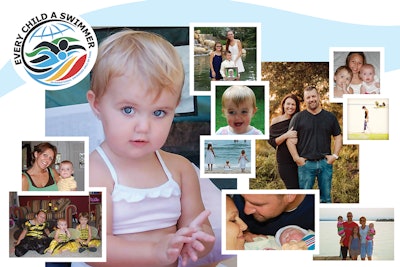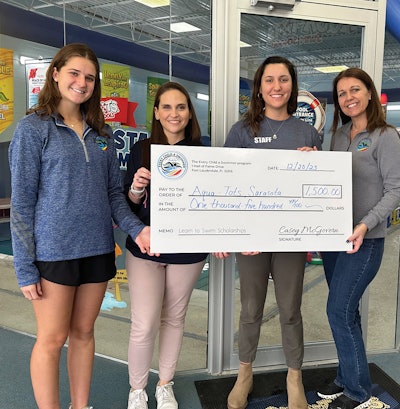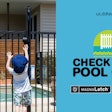
Drowning is silent and fast. It is the leading cause of death among children ages one to four, and the second leading cause of death among children ages five to 14. In as little as 20 to 60 seconds, a child can drown, which will leave a heart-wrenching absence in the lives of the surviving family members forever.
On August 3, 2009, Casey and Shannon McGovern were at home when their two-year-old daughter, Edna Mae, tragically drowned in their backyard pool. From the time Casey checked out of a grocery store to the time Edna Mae was in the emergency room, fighting for her life, only 29 minutes had passed. Half-an-hour was all it took for this family to become divided, never perfectly whole again.
Instead of dwelling on this brokenness, Casey and Shannon made it their life's mission to educate families on the risk factors associated with drowning, so that they could prevent others from experiencing the same kind of heartache they felt, and continue to feel, every single day since Edna Mae passed. Thanks to her connection with Bill Kent, International Swimming Hall of Fame chairman of the board, Casey was entrusted to lead the Every Child a Swimmer program beginning of 2022. This role is just one of the many ways she has been able to fulfill her "life's mission," and truly save the lives of hundreds of children and counting.
EDNA MAE MCGOVERN
Due to a misunderstanding with a coworker, what would have been a typical McGovern Monday in the Florida summertime, with Shannon at work and Casey watching their three girls at home, turned into both parents being home with the children, a friend, named Veronica, of the oldest daughter, Ally, coming over to hang out, and an in-house meeting taking place between Shannon and a new hiree.
"It was a wonky day that just kind of got squashed," says Casey. "We spent that afternoon in the pool together, getting out at staggered times. I got out first with Em and put her down for a nap, and then Shannon got out with Taylor next, our middle girl who was three at the time, and he allowed Ally to stay in the pool with her friend since they were older.
"While Em was napping, I went to the grocery store. When I got back to the house, Em met me as I walked in with the groceries, up from her nap. At around this same time, Ally and her friend had gotten out of the pool and were hanging out in Ally's room, along with Taylor. The new hiree had just arrived at our house for his meeting with Shannon, so the atmosphere was just busier than normal.
"I put Em on the opposite side of the kitchen counter from me as I started putting the groceries away. About half way through this task, Shannon called me into the other room to ask a work-related question; however, when I went back into the kitchen, Em was no longer where I left her. Naturally, my first inclination was to just go and look for her by myself.
"I went from bedroom to bedroom looking for her in the house, just taking my time. Our backyard wasn't even on my radar at first because I didn't view it as a safety hazard. We had a backyard fence, a pool with a fence around it and a swingset, which had, up to this point, always been places of joy and freedom for our family.
"After I couldn't find Em anywhere in the house, I decided to go check the swingset area because she loved swinging. In order to get there, I had to pass by the pool. I got about halfway past the pool when I noticed her. She was floating faceup, blue eyes wide open and not moving a muscle."
Casey ran through the gate and jumped into the water, grabbing Em and screaming out in horror. Thankfully, Shannon heard her screams, and rushed outside to help. He took Em from his wife, brought her to land, and started CPR.
"The new hiree was still there, and he was actually the one who ended up calling 911," says Casey. "To this day, I still remember the 911 operator telling me that I wasn't helping the situation. That I needed to just put the phone on speaker so that Shannon could hear the operator walk him through the compressions until the paramedics arrived. I was too hysterical to do anything but cry honestly.
"When the ambulance arrived, I got into it with Em, and we went to the hospital. She was immediately transferred from our local hospital to a larger trauma center in Fort Lauderdale, Fla. For the first 72 hours, she was put on ice so they could keep her temperature and swelling down, but because of this, we weren't able to really touch her.
"As a mother, when your child is hurting, all you want to do is care for them and comfort them, but I wasn't allowed. They let us do a few little things for her like brush her teeth, care for her eyes and rub her feet, but it wasn't the same as picking her up and holding her."
Within the first 24 hours of Em's drowning, the police had to interview both Casey and Shannon at separate times, as well as Ally and Taylor, so they could rule it as either an accident or intentional act. In Em's case, it was ruled an accident, but that could only be determined after the four family members told their sides of the tragic story.
"Drowning is a form of neglect because it wouldn't have happened under proper supervision," says Casey. "That's why the police have to get involved. That's why child protective services have to get involved. They're getting involved to prevent something like a drowning from ever happening again in your household."
Throughout that week, the McGoverns were hoping and praying for God to perform a miracle on their little girl. "We had a prayer chain; we had people come and lay hands on her; we played worship music; we had people reading her Bible scriptures and praying for her," says Shannon. "We did it all, but by Wednesday, Casey came to me and said that we needed to make a decision. The medical staff kept doing these tests on Em, and there just wasn't any improvement. As a mother, Casey had an inkling that our daughter wasn't there anymore and in my opinion, no one knows better than a mother."
On that Wednesday, they made the decision to donate Em's organs so that her life would help save the lives of others. They were allowed to donate everything but her eyes because her eyes weren't fully developed at the time of her passing; she was too young. That weekend, they further decided to take Em off of life support, and after signing the final paperwork, the family had 24 hours to say their goodbyes. Edna Mae McGovern officially passed away on Monday, August 10.
"Taylor was three years old at the time, so she didn't really understand what was happening to her sister; however, Ally was 11 years old, so she definitely understood," says Casey. "I remember Ally asking me, 'What's going to happen to us?' And then Shannon responded, 'We're still going to be a family. We're going to be broken, but we'll still be a family.' I think one of the greatest blessings of our marriage is that when I've been weak, Shannon's been strong, and vice versa, so we can always lean on each other and count on each other.
"Eventually, we were both strong enough to be able to walk away from her. We left her in the hospital bed, peacefully sleeping; she looked like a perfect angel baby. Honestly, I think Em was taken from us so that we could do this work. When we were in the hospital, we learned the statistics and the reality of children drowning incidents in the United States. We made it our life's mission to lower those statistics and change that reality."
On the day of Em's memorial service, Casey discovered she was pregnant with a baby boy. It was the chaos and focus this broken family needed in order to kickstart their healing. Outside of raising her son, Casey was also able to heal through educating the public on Em's story.
"Within the first month of Em's passing, we created a website, which was more for personal healing purposes than anything else," says Casey. "But one thing led to another, and anytime there was a speaking engagement or invitation, I just accepted it because educating the public on pool safety in any capacity felt like the right thing to do, and since Em drowned, it has always felt like the right thing to do for our family."
“She kept saying to me, ‘I don’t want another family to have to go through what we went through,’ so that became her mission. She wanted to educate other families on water safety so they never had to experience the loss of their child due to drowning. We were the family that didn’t think it could happen to us. But we quickly learned that it can happen to the best parents, and it can happen to the worst parents. You can’t watch your kids 24/7. Whether you are a helicopter parent or not, your child will get out of your sight. Drowning is silent. Drowning is quick. And trust me, if your child drowns, it will affect you for the rest of your life. For example, after Em’s passing, anytime one of my surviving kids got out of my sight, regardless of if a pool was involved or not, I immediately went into panic, ‘what-if’ mode, which really affected me.” —Shannon McGovern


EVERY CHILD A SWIMMER
The McGovern's mission to make "every child a swimmer" started with Casey and Shannon sharing their story to other parents, and then pointing those parents towards the appropriate water safety resources. From there, Casey tried teaching swimming lessons, and the couple even considered opening up a swim school of their own. However, this fell through, and Casey ended up taking a job with the Florida Department of Health to run their Drowning Prevention Program.
After being the Program Director for almost eight years, Casey resigned from the Florida Department of Health because she felt called to do more. In 2020, she reached out to her friend, Bill Kent, International Swimming Hall of Fame chairman of the board, and after quick and easy negotiations, she became the Program Manager for Every Child a Swimmer.
"The main goal of Every Child a Swimmer is to provide Learn to Swim scholarships to children who can't afford swimming lessons," says Casey. "We give money to swim schools — money that was donated to us by organizations in the industry — who then identify children in their communities to serve, through identifiers like food stamps, and ultimately, teach them how to swim, free of charge.
"We partner with swim schools all throughout the United States, and in 2023 alone, 610 kids, all over the age of one, received Learn to Swim scholarships, which equated to around $150,000 in donations. Sometimes, companies ask me how much I would like them to donate, and I can't answer that question. All I can tell them is to listen to their heart; to make a money commitment that they feel called to. Right now, my main focus as the Program Manager is to develop working relationships with swim schools, which will hopefully continue to grow and evolve over time, so that one day, Every Child a Swimmer is partnered with every swim school all throughout the world."
 As part of her Every Child a Swimmer program management tasks, Casey has worked to pass water safety education legislation in multiple states, as well as worked as the "middle-man" between pool/spa businesses and their donations to swim schools all throughout the nation so that more children learn how to swim, free of charge, lowering the unbearable death by drowning statistics.
As part of her Every Child a Swimmer program management tasks, Casey has worked to pass water safety education legislation in multiple states, as well as worked as the "middle-man" between pool/spa businesses and their donations to swim schools all throughout the nation so that more children learn how to swim, free of charge, lowering the unbearable death by drowning statistics.
In 2021, Casey helped pass and implement legislation in Florida, Georgia and Arkansas, along with five other pending states, with the ultimate goal of it getting passed all throughout the country. "The legislation requires all schools, K through 12, to share water safety tips and education at the beginning of each school year, along with where to go in order to acquire local swim lessons," says Casey.
A drowning can occur in as little as 2 inches of water; being educated on water safety is the first step to preventing a tragedy from happening. In the United States, an average of 3,500 to 4,000 people drown every year, which is an average of 10 fatal drownings per day. Drowning doesn't discriminate; it can happen to anyone at any time. 23% of child drownings happen during a family gathering near a pool. 87% of drowning fatalities, for children younger than five, happen at home, in pools or hot tubs. Children, ages five to 17 years old, are more likely to drown in natural water, such as ponds and lakes.
The CDC reports that for every one fatality, at least eight people are drastically impacted, which is something Casey refers to as the ripple effect. "Outside of our family being affected by Em's drowning, our neighbors, community, church, hospital staff, first responders, etc. were also affected. The first responder involved with us said that for every preventable death, especially when children are involved, it feels like another rock in their pocket, weighing them down. That's why burn out and suicide rates are so high among first responders; they just can't take all that weight. Ultimately, one drowning can truly impact the lives of so many people.
"Together, through water safety education, we can make a difference. We can keep Em's memory alive by making EVERY CHILD A SWIMMER!"
For more information, or to get involved, visit https://everychildaswimmer.org/, or follow Every Child a Swimmer on LinkedIn, Facebook, Instagram and/or YouTube. To speak directly to Casey, you can reach her by email at [email protected] or by phone at (954) 275-9035.





































